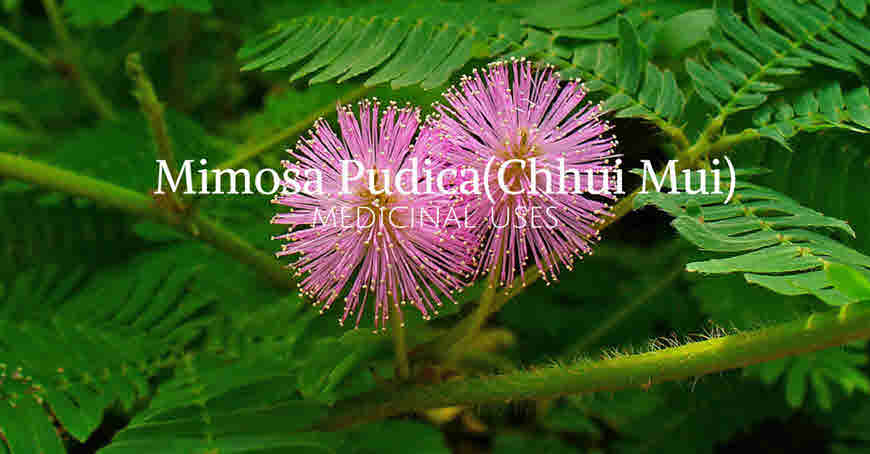Mimosa pudica (from Latin Pudica meaning shy, shrinking) is also known as Sensitive Plant and touch- me-not. It is a perennial short prickly herb with sensitive leaves which fold and drop on touching. This plant is native to tropical America and Australia. Mimosa belongs to the taxonomic group Magnoliopsida and family Mimosaseae.

This plant is useful in the treatment of various diseases. Its root is bitter, acrid, cooling, heals wounds, anti-venom and used in the treatment of excessive bile secretion, leprosy, dysentery, vaginal and uterine complaints, inflammations, burning sensation, fatigue, asthma, leucoderma, skin diseases, etc. This medicinal herb is useful when diseases in the body is due to aggravation of Pitta, and Kapha dosh.
Sensitive pant/touch-me-not or Chui mui is semi-erect subshrub native to tropical America and Australia. It is also found in India and known as Laajwanti becuase of its leaves sensitivity for touch. It leaves fold and drop on touching. It is a medicinal herb with antibacterial, anti-venom, antifertility, anticonvulsant, antidepressant, aphrodisiac, and various other pharmacological activities. Mimosa propagates through seeds. All five parts of Mimosa plant (Panchang – leaves, flowers, stems, roots, and fruits) are used for medicinal purpose.
Botanical details
| Taxonomy Class: Equisetopsida Subclass: Magnoliidae Superorder: Rosanae Order: Fabales Family: Leguminosae/ Fabaceae – Mimosoideae Genus: MimosaLatin name: Mimosa pudica |
Hindi: Laajvanti and Chhui-mui Bengali: Lajjabati Telugu: Attapatti and Peddanidrakanni Tamil: Tottaaladi and Thottalchnungi Kannada: Lajja, Nachika and Mudugu-davare Malayalam: Tintarmani Vernacular names Sanskrit: Lajjalu, Laajwanti English: Sensitive plant |
Plant Morphology
- Stem: Rachis are clothed with prickles.
- Flowers: globose, pink heads. Pollinated by winds and insects.
- Pods: Small, flat, straw color with many bristles.
- Seeds: 3-5
- Fruits: Cluster of 2-8 pods with prickly margins
- Root: Cylindrical, tapering, with secondary and tertiary branches, varying in length up to 2-cm thick, surface more or less rough or longitudinally wrinkled; greyish-brown to brown, cut surface of pieces pale yellow, fracture hard, woody, bark-fibrous; odour, distinct; taste, slightly astringent.
- Leaf: compound leaves with one or two pairs of sessile, hairy pinnae, alternate, petiole, stipulate, linear lanceolate; leaflets 10–20 pairs, 0.6–1.2-cm long, 0.3–0.4-cm broad, sessile, obliquely narrow or linear oblong; obliquely rounded at base, acute, nearly glabrous, yellowish green.
Pharmacological Activities
- Diuretic activities
Its leaves decoction promotes urine production with excretion of sodium and potassium ion, but without affecting potassium excretion. - Lowers abnormal uterine bleeding
The decoction of roots is useful in the management of abnormal uterine bleeding. - Anti-fertility effect
The oral intake of roots causes decreases in fertility. The lab test on mice, shows altered estrous cycle and increased number of degenerated ovum. - Antivenom activity
The aqueous extract of roots shows activity against snake venom. - Hyperglycemic effect
Its leaves causes increase in blood sugar in the body. - Antimicrobial, antifungal, and antiviral activity
The various parts of Mimosa plant show antimicrobial, antifungal, and antiviral activity. - Wound healing activity
The roots have wound healing activities and can be used for faster healing of cuts and wounds.
Medicinal Uses of Chhuimui
Mimosa is useful in treating various ailments. It can be applied externally on boils, ulcers, wounds, fungus, cuts and piles. In Ayurveda, its use is mentioned for the skin and vaginal diseases, swelling, burning sensation, diarrhea, etc.
This plant is effective in treating bleeding disorders like menorrhagia, excessive uterine bleeding, and dysentery with blood, mucus and piles.
Here are few remedies that can be done at home to cure various ailments
- This herb is very useful in curing heavy, abnormal uterine bleeding and skin diseases.
- Bronchial asthma
Prepare juice of the plant Panchang and take in a dose of 10-30 ml. - Diabetes
Dry roots and leaves of the plant. Pulverise and prepare powder. Take ths powder in a dose of 2-5 grams. - Diarrhoea (athisaar), amoebic dysentery (raktaatisar)
Dry its roots and pulverise to prepare powder. Take this powder (3 gm) with curd. Or Prepare decoction by boiling 5 gm root powder, in water (400 ml) till volume reduces to 100 ml. Filter and drink twice a day - Gandamala, glandular swellings
Extract fresh leaves juice of Mimosa pudica and take 20-40 ml once a day for a few weeks. - Heavy menstrual bleeding
Take fresh roots juice 5 ml, with honey and black pepper (Piper nigrum) every 2 hours, during the menstrual period. - Indigestion
Drink fresh leaves juice in a dose of 30 ml - Jaundice
Take its fresh leaves juice (20-40 ml), twice a day for three weeks. - Piles, improving sexual potency in men
Prepare powder of its leaves. Take this powder in a dose of 1 teaspoon with milk, twice a day. - Stomach ache, intestinal worms
Take its leaves paste once a day, with honey, empty stomach for 3-4 days. - Stones, Diabetes, Snake bite
Prepare decoction of its roots (10 gm) in 400 ml water and drink twice a day. - Gum problems, toothaches
Prepare root decoction and use frequently for gargling. - Glandular swellings, hydrocele
Externally apply leaves juice on the affected areas. - Wounds, itching
Apply root paste on the affected area with the help of cloth. - Sagging breasts
Prepare a paste of Mimosa pudica and Ashwagandha roots. Apply this paste on breasts. - Abscess, boils for pus release and quick healing, fistulous sores
Apply leaves paste at affected area.
Which part of mimosa pudica plant treats impotence,dose and preparation.